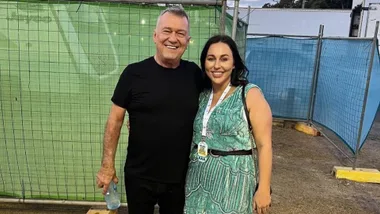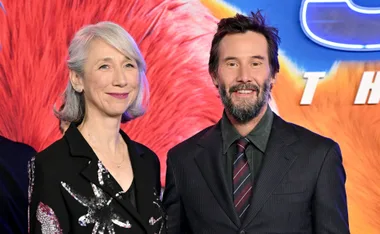This month sees the release of a book that tells the shocking, true story of Katherine Knight, the first Australian woman to be sentenced to prison for life. Her crime- the ritual slaying and skinning of her defacto husband, made worse by the fact that she then cooked some of his body parts and served them on dinner plates- is the most gruesome crime ever committed in Australia.
In her book, Beyond Bad- The life and crimes of Katherine Knight, Australia’s Hannibal (Random House $24.95), Australian journalist Sandra Lee investigates the crime, talks to police, recreates the murder with the help of forensic experts, delves into the backgrounds and emotions of the victim, the perpetrator and their families, and in so doing, attempts to examine the question of mad versus bad.
Sandra has 17 years experience in daily newspapers and magazines, here and in the US. She was formerly Assistant Editor and Op-Ed columnist with The Daily Telegraph in Sydney where she wrote about society and crime.
As a foreign correspondent, Sandra spent more than three years based in New York, where she has interviewed murderers and movie stars. She reported on the Branch Davidian siege at Waco in Texas the day American authorities burned it to the ground, covered the serial killings of Jeffrey Dahmer and shot pool with Great Train robber Ronnie Biggs at his home in Brazil.
Now a freelance journalist and author, she writes occasional opinion columns for The Australian and the Sydney Morning Herald and has a syndicated column in three Fairfax newspapers. Sandra lives in Sydney.
Q: WHAT MADE YOU DECIDE TO WRITE THE BOOK?
A I was horrified by the extent of Katherine Knight’s murderous acts and wanted to know what would make a woman do the things she did. We have all heard of stories about husbands and wives killing their spouses in a one-off act of fury or rage or jealousy or passion – and on a certain level we can understand that. But there hasn’t been a woman known to have murdered, then skinned, decapitated and cooked her lover in an act of brutal revenge.
Like most people, I was stunned that someone could even conceive of such deliberate and evil behaviour, and secondly, find the will to execute it. But Knight did, and according to expert testimony during her sentencing hearing, she enjoyed it. What separates her from the rest of us – what makes some people choose to be so bad?
Q: WHAT DID YOU SET OUT TO ACHIEVE WITH THIS BOOK?
A I wanted to write a book that told the story of love, revenge, passion and murder, while examining the concept of mad versus bad. Why are some people who seem like perfectly normal members of society capable of extreme acts of violence and murder? When we are faced with extreme crimes like the ritual murder of John Price– or Pricey, as everyone knew him – people readily put the actions of the criminal down to insanity or madness. It’s easier for us to accept such barbaric behaviour if we can categorise it by saying, “Oh they must be sick”, or, “she’s mad”. But, in fact, some people do bad things because they want to and because they can, and because it serves their purpose to be bad. Katherine Knight chose her actions. She could have stopped at any time after stabbing Pricey to death. She didn’t.
But as I learned more about Pricey, I realized that there was also a good, ordinary man who died a brutal and untimely death. And he had his story, too. I wanted to ensure that Pricey was not remembered just as a murder victim, and I wanted to paint a portrait of him that would honour his memory. Pricey was a good, hard-working, decent man who loved his family, his mates, his work and his beer. What has been incredibly gratifying to me is that one of the first reviewers who read Beyond Bad said that she felt she knew Pricey from the book in a way that readers never get to “know” the murder victims from brief newspaper stories and court reports. They tend to be anonymous and the murder is soon forgotten, and subsequently, they become just another crime statistic. Pricey didn’t deserve that.
Q: HOW DID YOU APPROACH KATHERINE KNIGHT AND DID SHE CO-OPERATE?
A I wrote three letters to Knight, who is serving a life sentence at Mulawa Women’s Correctional Centre at Silverwater. I also asked one of her lawyers to ask her if she would agree to an interview, and I contacted the Department of Corrective Services seeking permission to interview her. Katherine Knight refused my invitations to tell her story. She knew I was writing the book – as her family had told her. She also showed my letters to one of her fellow inmates who wrote to me asking me to tell her story in The Australian Women’s Weekly (coincidentally, she was convicted of killing her husband, as well). Knight’s fellow inmate defended her and said Katherine was a nice woman and had been behaving perfectly well while in jail.
I was slightly bemused when my correspondent wrote that both she and Katherine objected to my use of the word “perpetrated” in one letter I sent Knight. She had pleaded guilty to murdering John Price and was, I wrote, “the sole perpetrator of the crime”. The woman who wrote to me said that had I wanted to gain Katherine’s confidence, I could have used a word other than “perpetrate” which they felt was harsh. It’s interesting that Knight focused on that.
Q: WAS HER FAMILY ASHAMED OF HER AND HAVE THEY ALL REJECTED HER?
A I interviewed Katherine’s father Ken Knight and her youngest brother, Shane Knight, and one of her older half-brothers, Barry Roughan. Her father and Shane Knight can’t understand or fathom what she has done. How could they? They are as shocked and horrified as anyone, but they are family, and they have not rejected her.
Similarly, her twin sister, Joy, who refused to talk to me, visits Katherine in prison. Barry Roughan visited her a couple of times – the last time during which Katherine cried on his shoulder. He believes that what she has done is evil. He says he can’t forgive her, but he doesn’t hate her, and no, he won’t be visiting her again. None of her family can quite believe she did what she did, and the crime has ripped the family apart. Another brother, Charlie, gave a statement to police in which he said Katherine had repeatedly told him she was going to kill John Price. Charlie is no longer in touch with Ken and Shane and Joy, neither is Barry Roughan.
Q: DOES KATHERINE KNIGHT HAVE HER GOOD SIDE?
A As surprising as it seems, yes, she does have her good side. She is an extraordinarily complicated and complex woman. She is far from being the one-dimensional caricature of evil. Many of those who knew her – even her ex-husbands and boyfriends- said she was generous and good fun, and would be the first one to lend a helping hand if anyone needed it. She turned, though, when someone crossed her, or did something she didn’t like – then she went in to payback mode. Revenge was a weapon of hers. You had better watch out if you crossed Katherine Knight.
Q: DID YOU TALK TO JOHN PRICE’S FAMILY?
A Yes, I spoke at length with his ex-wife Colleen Price, with whom Pricey remained best mates even after they separated and divorced, and his youngest daughter, who I called Jackie in the book because she is under 18, and her name was obviously suppressed by a court order. I also interviewed several of his friends and colleagues, all of whom, like his family, are still shocked and traumatised by his murder.
Q: HIS CHILDREN, ESPECIALLY, MUST BE TRAUMATISED?
A Yes, they are, and it’s no wonder. Katherine Knight targeted two of Mr Price’s children in her brutal and vile murder and revenge plot.
She cooked part of her lover’s body and served it up as meals for Johnathon and Jackie. She also wrote a vindictive note to them- the contents which were also suppressed by the judge. She scrawled their names on kitchen paper and tucked the paper under the dinners as “nameplates”- a clear sign of what she intended. That was beyond cruel. Attacking John Price’s children showed just how deep her desire for revenge ran. She wasn’t content with murdering their father, she had to defile his memory for his children. For a mother to do that to other children is simply unspeakable and reveals the truly dark side of her nature. The murder was as violent as any, but what she did in the aftermath was beyond bad. Jackie Price, who is now 17, is haunted by the murder, and like her older brother and sister, Johnathon and Rosemary, has her good and bad days. She hates Knight, and told me that one day she would like to confront Knight to ask her why she did it.
Q: YOUR BOOK GOES INTO GREAT DETAIL ABOUT THE CRIME – DID YOU VISIT THE CRIME SCENE?
A Only the police and forensic experts were allowed into the crime scene at the time of the murder, and in the days after, while the investigation was underway. But I spent quite a bit of time in Aberdeen and visited the house where John Price was murdered, and also, Katherine’s house in Aberdeen.
As in all murder cases, the NSW Police Service forensic crime scene unit videotapes the crime scenes, and in this case, the video was played on the first day of the sentencing hearing in open court in October last year. It showed everything that had happened in the house that early March morning in 2000. It started with a shot out the front of the house, and moved slowly up to the front door where Mr Price almost escaped. It then cut to his bedroom, and followed his attempted escape down the blood-stained hallway. For me, the videotape was shocking and ghostly. It had no commentary, but it showed exactly what happened, including the skinning, the cooking and the meals callously laid out in the kitchen for his children.
I also interviewed several of the police involved in the investigation and who were at the awful crime scene, the forensic pathologist who conducted the post-mortem, and one of the women who cleaned up the house after the police were finished with their preliminary investigations.
Q: DID THIS CASE DEPRESS OR UPSET YOU AT TIMES?
A Yes, it did – many times and in many ways. I was absolutely horrified at the capacity for evil that Katherine Knight had. As a woman, we’ve all been through break-ups, and we are all enormously hurt over them. But to be upset is one thing; to cold-heartedly plan a murder and then to do what Katherine Knight did afterwards goes beyond anything imaginable. It was a symbolic defilement of a man she said she loved. It was absolutely depraved and pre-meditated. She even robbed his bank account when she was done.
I also felt desperately sad for Pricey’s family, and for his bosses and mates who alerted police that he was missing. What they went through is indescribable.
Q: DID YOU HAVE A WAY OF DEALING WITH THE HORROR?
A When I wasn’t researching, interviewing or writing the book, I spent a lot of time with family and friends, trying to keep my mind off the dark side of humanity. As well, I’m lucky to have four gorgeous little boys in my life – two of whom are my godchildren. Their innate goodness and innocence brought a lot of light into my life, which, to be honest, was pretty dark during the writing of the book.
But, at the end of the day, the horror I endured was nothing compared to what John Price’s family have to endure every day, or what the police officers who discovered the body and conducted the investigation still have to endure. One officer has never returned to work, and Bob Wells, the Detective Sergeant whose brilliant police work was rewarded with Knight’s murder conviction and an unprecedented life sentence, still sees a counsellor to help him cope with the trauma. I don’t think we ever give enough credit to the men and women in blue who work at the frontline of crime every day.
Q: DO WE KNOW WHAT MADE KATHERINE KNIGHT UNDERTAKE SUCH A CRUEL MURDER?
A Yes. In a word- revenge. John Price wanted her out of his home, and out of his life – and she didn’t want to go. When he made it clear it was over and he wasn’t going to relent, she decided to murder him. If she couldn’t have him, then no one could. Revenge is one of the most common motives in murder, but, as this case shows, it’s also one of the most callous and cruelly personal.
Q: AFTER A BOOK SUCH AS THIS, ARE YOU KEEN TO WRITE ANOTHER TRUE LIFE CRIME OR WOULD YOU LIKE TO TRY SOMETHING DIFFERENT?
A I would like to do another true crime, because like so many people, I’m at once frightened and fascinated by the motivations of seemingly normal and average people who do the most evil things. I’m interested in the psychology of crime- why some people choose to be bad. What makes them tick? How different are they from you and me?
But, I’d also like to write a biography or maybe even try my hand at something much lighter, like a romantic comedy.
In the meantime, there is my first professional love- journalism.











